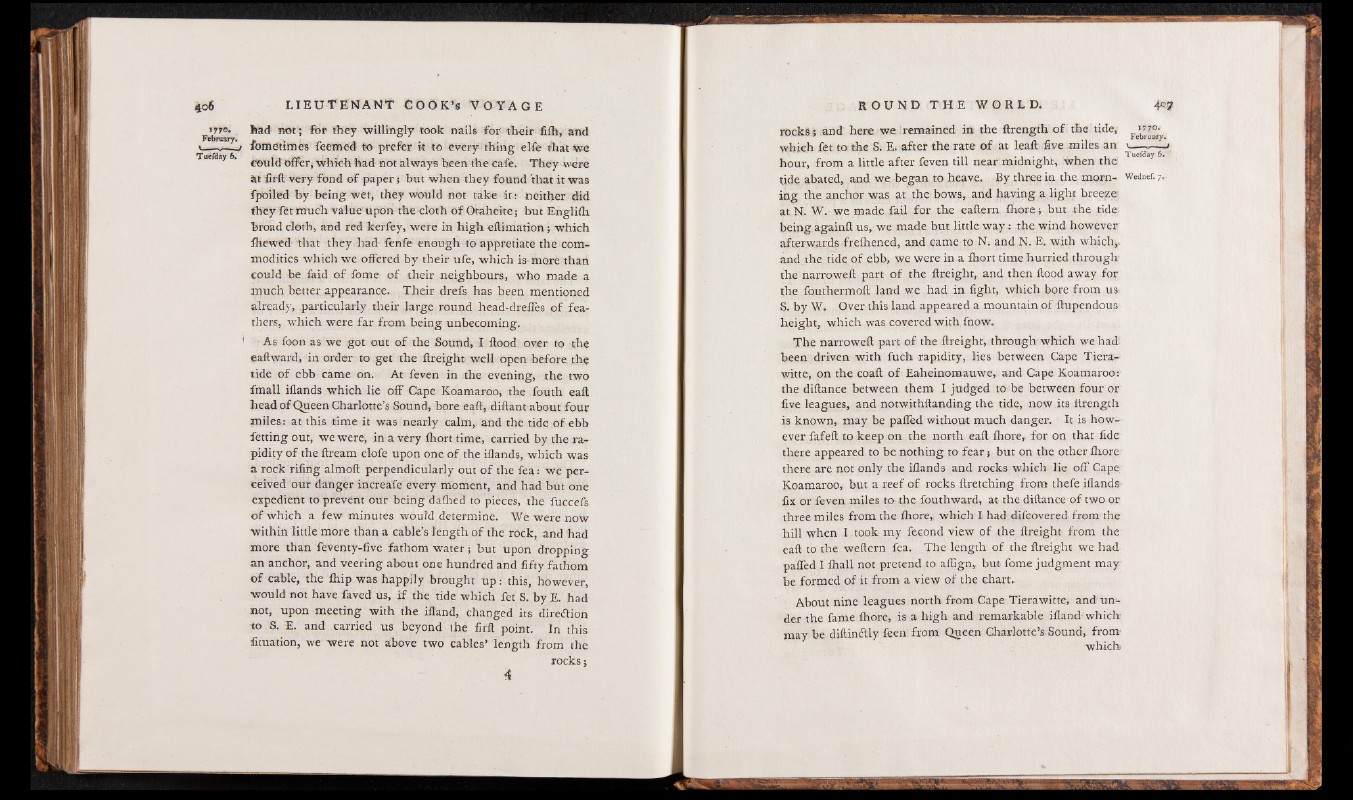
»7T9.
February,
Tuefday 6.
had not; for they willingly took nails for their fiffa, and
fometimes feemed to prefer it to every thing elfe that we
Could offer, which had not always been the cafe. They were
at firft very fond of paper 5 but when they found that it was
fpoiled by being wet, they would not take it-: neither did
they let much value upon the cloth of Otahekc; but Englifh
broad cloth, and red kerfey, were in high eftimation ; which
fhewed that they had fenfe enough to appretiate the commodities
which we offered by their ufe, which is- more than
could be faid of feme of their neighbours, who made a
much better appearance. Their drefs has been mentioned
already, particularly their large round head-drefles of feathers,
which were far from being unbecoming.
As foon as we got out of the Sound, I flood over to the
eaftward, in order to get the ftreight well open before the
tide of ebb came on. At feven in the evening, the two
fmall iflands which lie off Gape Koamaroo, the fouth eaft
head of Queen Charlotte’s Sound, bore eaft, diftant about four
miles: at this time it was nearly calm, and the tide of ebb
fetting out, we were, in a very fhort time, carried by the rapidity
o f the ftream clofe upon one of the iflands, which was
a rock riling almoft perpendicularly out of the fea t we perceived
our danger increafe every moment, and had but one
expedient to prevent our being dafhed to pieces, the fuccefs
of which a few minutes would determine. We were now
within little more than a cable’s length of the rock, and had
more than feventy-five fathom water; but upon dropping
an anchor, and veering about one hundred and fifty fathom
of cable, the fhip was happily brought up 1 this, however,
would not have faved us, if the tide which fet S. by E. had
not, upon meeting with the illand, changed its direction
to S. E. and carried us beyond ihe firft point. In this
fituation, we were not above two cables’ length from the
rocks;
rocks j and here we remained in the ftrength of the tide,
which fet to the S. E. after the rate of at leaft five miles an j
hour, from a little after feven till near midnight, when the 1
tide abated, and we began to heave. By three in die morn- Wcdnef. 7.-
ing the anchor was at the bows, and having a light breeze
at N. W. we made fail for the eaftern fhore; but the tide:
being againft us, we made but little way: the wind however
afterwards frefhened, and came to N. and N. E. with which,-
and the tide of ebb, we were in a fhort time hurried through-
the narroweft part of the ftreight, and then flood away for
the fouthermoft land we had in fight, which bore from us
S. by W. Over this land appeared a mountain of ftupendous-
height, which was covered with fnow.
The narroweft part of the ftreight, through which we had
been driven with fuch rapidity, lies between Cape Tiera-
witte, on the coaft of Eaheinomauwe, and Cape Koamaroo:
the diftance between them I judged to be between four or
five leagues, and notwithftanding the tide, now its ftrength
is known, may be paffed without much danger. It is however
fafeft to keep on the north eaft fhore, for on that fide
there appeared to be nothing to fear; but on the other fhore
there are not only the iflands and rocks which lie off Cape
Koamaroo, but a reef of rocks ftretching from thefe iflands
fix or feven miles to the fouthward, at the diftance of two or
three miles from the fhore, which I had difcovered from the
hill when I took my fecond view of the ftreight from the
eaft to the weftern fea. The length of the ftreight we had
paffed I fhall not pretend to affign,. but fome judgment may
be formed of it from a view of the chart.
About nine leagues north from Cape Tierawitte, and under
the fame fhore, is a high and remarkable ifland which-
may be diftinftly feen from Queen Charlotte’s. Sound, fromwhich*